When I put my beagle puppy into the crate for the first time, he started howling at his highest pitch. Back then, I was a total newbie. I didn’t know much about crate training. There was hardly anything on the internet about beagles. I had to consult a Professional Dog Trainer to crate train my first beagle. I observed all the techniques, and by the time I got my second beagle, I was all ready. This time everything went flawlessly. There was no screaming, no howling. So let’s get the ball rolling and learn how you can crate train your pet beagle.
NOTE: The process for crate training a beagle puppy and beagle dog remains the same.
Getting started
The right crate training can create a safe and personal space where your beagle can relax and feel secure. You can learn more about crate training your dog by joining an online training course like this one. A crate is not a cage; instead, a crate is like a home of your pooch.
Crate training should never be forced upon your four-legged pal. Instead, your pooch should think the crate as his house. A crate should be comfortable and secure space for your beagle. Your beagle should like being in his crate.
Things you will need
- A crate, of course. If you haven’t bought one yet, you can go through my recommendation of the best three crates perfect for a beagle.
- Comfortable bed.
- A soft blanket
- Treats
- Your beagle’s favorite toys
- Dinner Bowl
- And most importantly, your time because your beagle doesn’t know how to crate train himself.
How to Crate Train your Beagle
Step 1: Create a positive environment inside the crate
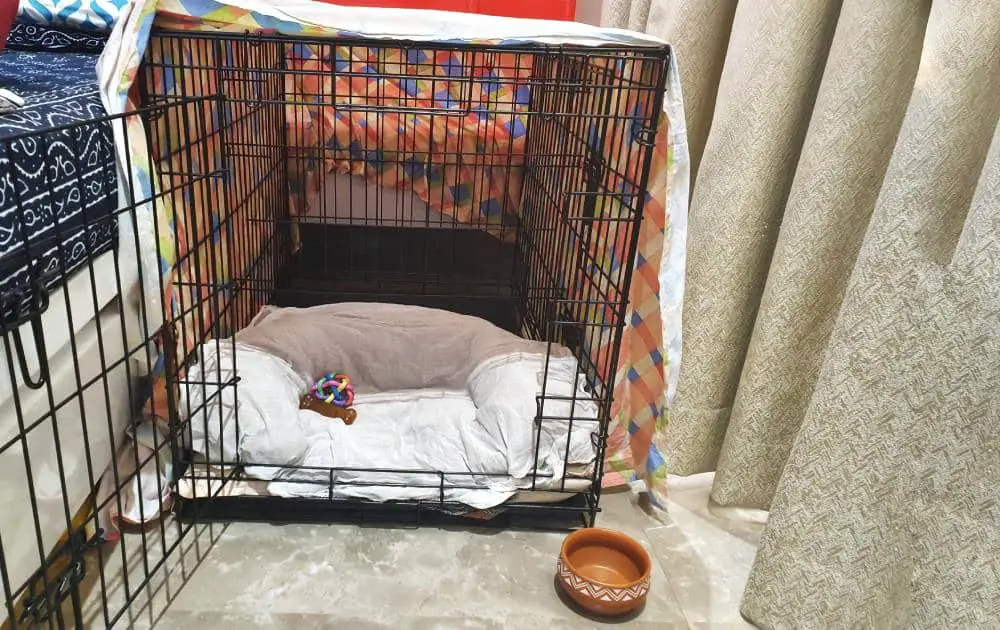
A crate should be a safe and comfortable place where your beagle can rest. It is essential that your pooch likes the crate. You can do the following thing to make the crate beagle-friendly:
- Put a comfortable dog bed inside the crate
- It is necessary that your beagle feels safe inside. For that, you can cover the crate with a blanket and make it a dark and confined space.
- Keep your beagle’s favorite toys inside the crate.
Step 2: Encourage your beagle to go inside the crate

Once the crate is ready, its time to introduce it to your pooch.
- Keep the crate door open and let your dog examine it. If he goes inside the crate, give him a treat, and praise him. If he doesn’t, it’s totally fine, do not force him.
- Give him a treat just for being around the crate.
- Now put a treat inside the crate and let him go inside and get that. Let him find that the crate is a comfortable and rewarding place to be in.
Step 3: Establish a positive association with the crate
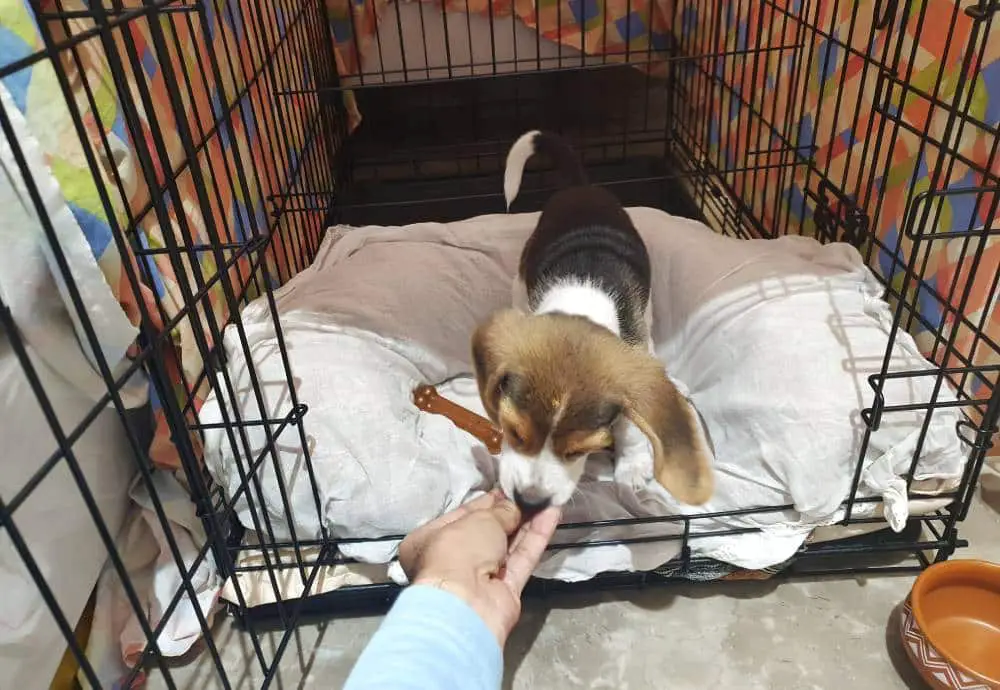
Every time you see your pooch going inside the crate, click the clicker or say the marker word and treat him. It will encourage this behavior.
To make him more comfortable inside the crate, you can even play some crate-games. If your beagle is just a puppy, then you can put a trail of treats leading to the crate where there are ample treats. If your pal knows how to play fetch, you can throw the ball inside the crate and ask him to fetch. This will make the crate a part of your beagle’s environment.
In this way, you will be able to associate good things with the crate for your beagle.
Step 4: Close the door for the first time

Once your beagle is aware and comfortable of the crate, its time to close the door for the first time. In this step, we will close the door for 5 seconds. We don’t wanna stress our little pal or give him anxiety, so make sure the duration is no more than 5 seconds.
- Put the food bowl filled with his favorite food inside the crate
- Let him get inside the crate and eat his meal.
- When he is eating, close the door for 5 seconds.
Your pooch might not even notice it. Gradually extend the time the door is closed until you have successfully managed to keep the door closed for his entire eating session. Open the crate as soon as he notices the closed door and then give him a treat and praise him.
Step 5: Increase the duration
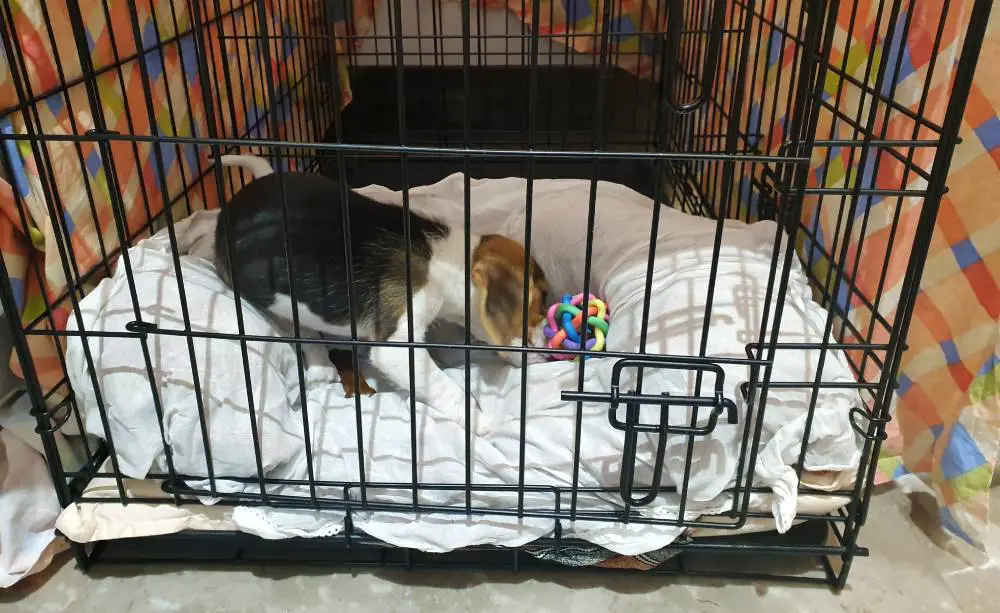
By this step, your pooch is comfortable with the crate. He knows that the door of the crate can be closed. Now its time to teach your beagle how to stay inside when the door is closed.
When to do this: If you put your beagle in the crate when he wants to play, he would, of course, wanna come out. You will need to do this step when your pooch is calm and tired. So make sure your pooch has had proper exercise and is done with soiling before doing this.
How to do it:
- Make sure the crate has a comfortable bed or a blanket on which your pooch sleeps.
- Try to get him inside the crate by throwing in his favorite chew toy.
- If he remains calm inside, close the door.
- Observer your beagle for the next 20 seconds.
- Put your hand/fingers inside the crate from the bars and hold on to a toy to make it less scary for your pooch.
- Stay beside the crate so that your beagle feels safe.
- If he gets anxious or starts howling, decrease the time to 5 seconds.
- But if the pooch remains calm for those 20 seconds, open the door and praise him, make a big fuss about it, give him lots treats. Increase the time gradually.
Few things you should do to make your beagle comfortable inside the crate:
To make the crate less scary for your beagle, try doing the following:
- Put your hand inside the crate. If you cannot put your hand inside, at least put your fingers inside the crate.
- Talk with your pooch and let him know you are there for him.
- Make sure your pooch’s favorite toy is already inside the crate.
- Do not increase the time right away. Make it a slow process.
Once your beagle can stay in the crate for 5 minutes, move on to the next step.
Step 6: Step away from the crate
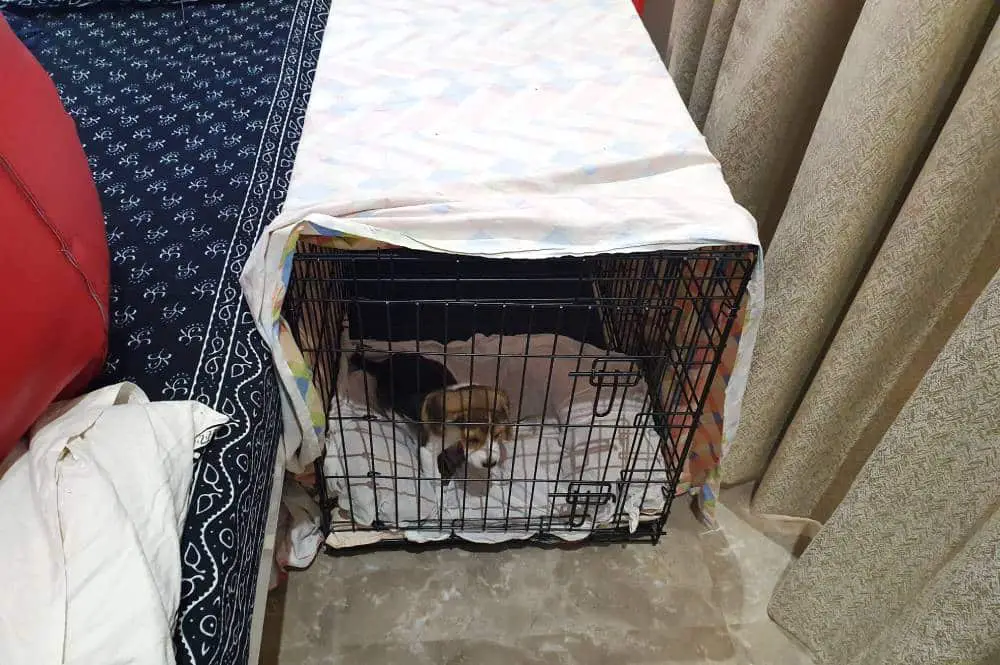
Now that your beagle feels comfortable inside the crate with closed doors, its time to teach him to stay inside the crate in your absence.
- Put your pooch inside the crate when he is calm and tired.
- Get up, take a few steps away from the crate, stop, and return.
- Open the door
- And praise him and give him treats.
- Gradually increase the distance.
- Repeat this until you can walk outside the door and come back.
Step 7: Work on Distance and Duration
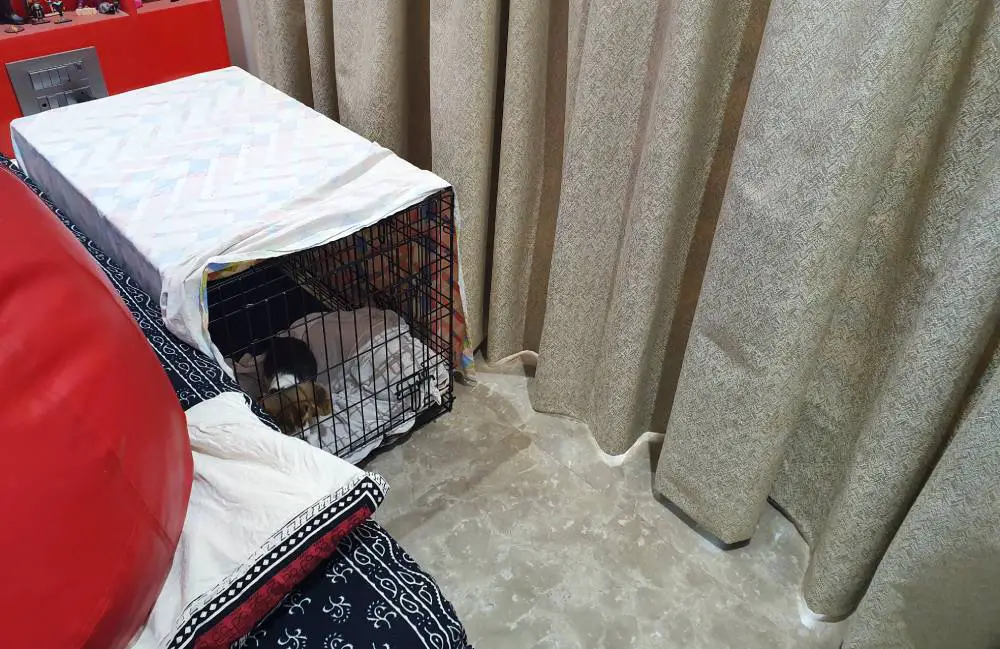
By now, your beagle can stay inside the crate for 5 minutes and can remain calm even when you walk away. Start with stepping out of the room for 5 seconds before your return. Gradually build up the time.
Step 8: Let your beagle out only when he is calm
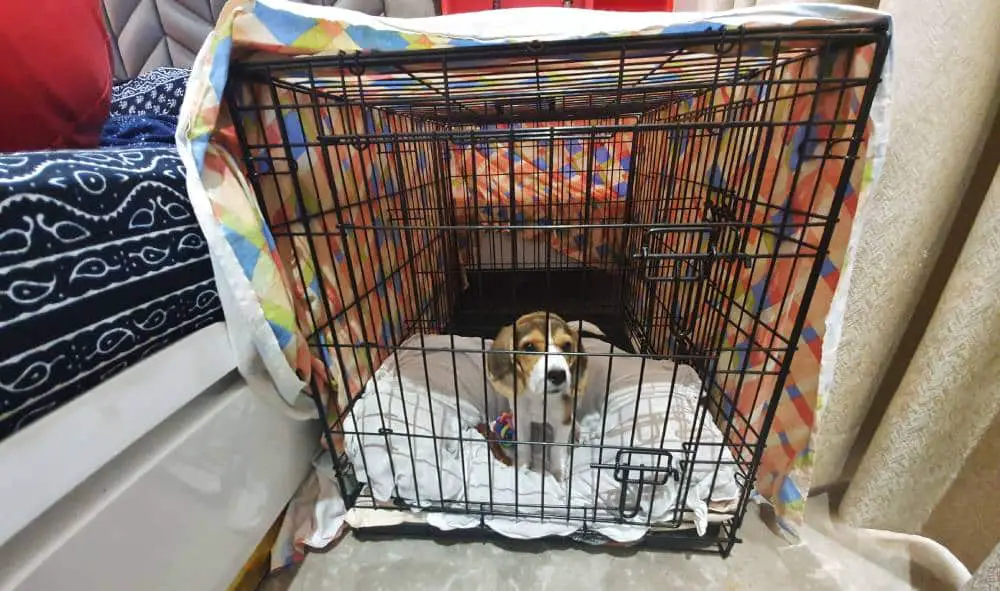
You must make it clear to your beagle that silence is the only way to get what he wants. If you come back and find your beagle howling, DO NOT OPEN THE DOOR. Let him calm down. Once when he stops howling, go ahead and let him out.
If you open the door when your pooch is howling, it will just encourage this behavior, and he would howl longer next time.
NOTE: Crate training is not something you do in a day or two. Beagles are stubborn and have severe separation anxiety issues. You will need to work on the entire process for weeks until you can leave your beagle in the crate for 30 minutes without stressing him.
Crate Training Do’s and Don’ts
Do Keep giving treats
Keep giving your pooch occasional treats even after he is crate-trained. Treats will keep him motivated. Leave a surprise treat in the crate to keep your pooch excited.
Don’t use the crate for punishment
Never use the crate to punish your beagle. Your pet could associate the crate with a negative experience and stress out. The crate is supposed to be a safe and comfortable place for your beagle, and it is necessary for him to like it.
Do take them out for Potty
Take them outside for potty right after you open the door. This will also help you house train your beagle alone with crate training.
Don’t leave your beagle in the crate for too long
The crate is not your beagle’s babysitter. Do not leave him in the crate for too long, or it could cause separation anxiety, and depression. If your pooch is just a puppy, then do not leave him alone inside the crate for more than three hours a day. Refer to this chart to know how long you can leave your beagle inside the crate according to his age:
| Age | Maximum Time |
|---|---|
| 5 to 8 weeks old | 10 to 20 minutes |
| 9 to 10 weeks old | 30 to 60 minutes |
| 11 to 14 weeks old | 1 to 3 hours |
| 15 to 16 weeks old | 3 to 4 hours |
Do create a confined and tight area in the crate
Most crates come with a partition that you can use to divide the crate and create a confined and tight area for your beagle according to his size. Don’t worry, it’s not cruel. Beagles like tight spaces, it makes them feel more secure.
Don’t put harness, collar, or any cloth on your beagle while crate training.
Your beagle should always go naked in the crate. Remove Collar, ID tags, harness, clothes before putting him in the crate. Harness, cloth, or id tag can easily get caught between the bars of the crate, causing some possible severe dangers.
Why is Crate Important for your beagle?
You already know how mischievous beagles are. Leave a beagle unattained for a moment, and you will find him chewing your furniture. Apart from destroying furniture, one other thing beagles love to do is eating. Your pooch will chew and swallow everything that fits in his mouth. Last week my neighbor’s beagle, who is six months old, swallowed her hair-band. They had to perform surgery to get that hair-band out of his body. And that’s why a beagle needs a crate.
Keeping your beagle in a crate may seem like a cruel thing, but it’s actually the opposite of it. Right crate training can create a safe and personal space where your beagle can relax and feel secure. A crate is not a cage; instead, a crate is like a home of your pooch.
Benefits of Crate Training your beagle
Crate training is benefited to both you and your pooch. Apart from being a comfortable and secure place for your pup, a crate also provides you a peace of mind that your pooch is safe and sound. Some other benefits of crate training your beagle are:
- Keeps your beagle safe: No matter how good you beagle-proof your house, your pooch will find something that could harm him. Beagles go crazy when they are alone and bored. A crate is a way to keep them safe when they are unattained. One beagle owner shared his story on Reddit. The beagle managed to find his owner’s medicines and swallowed the entire pack. After tons of expensive trips to the vet, his beagle was finally out of danger. And that’s why crate training is necessary, especially for a beagle.
- Reduces anxiety: When crate trained properly, it becomes a place where your beagle loves to be. And keeping him in it will reduce anxiety and stress.
- Convenient for transport: If your beagle is just a puppy, then the crate becomes a convenient way to take him to the vet.
- Helps with Traveling: Who doesn’t wants to travel with a dog. While traveling, you cannot just keep your dog unattained in the backseat of your car. This is when a crate comes in play.
- Protect your furniture: We see it as a nice piece of furniture, a beagle sees it as an opportunity to chew. While teething, your beagle would try to chew everything and anything when left alone. Putting him in a crate will help you save your furniture.
- Post-surgery Recovery: A crate plays an essential role in the post-surgery recovery of your beagle. You cannot allow your beagle to do activities when he is recovering from surgery (spray, neuter, fracture, etc.). Exercising or physical activities could lead to surgery failures. Your pooch would need maximum rest to recover faster. They will be more comfortable, happier, and safer inside their crate.
- Helps with Housetraining: Beagles usually don’t soil where they sleep. Keeping them in the crate will also help your house train them.
Where you should Put your Dog’s Crate
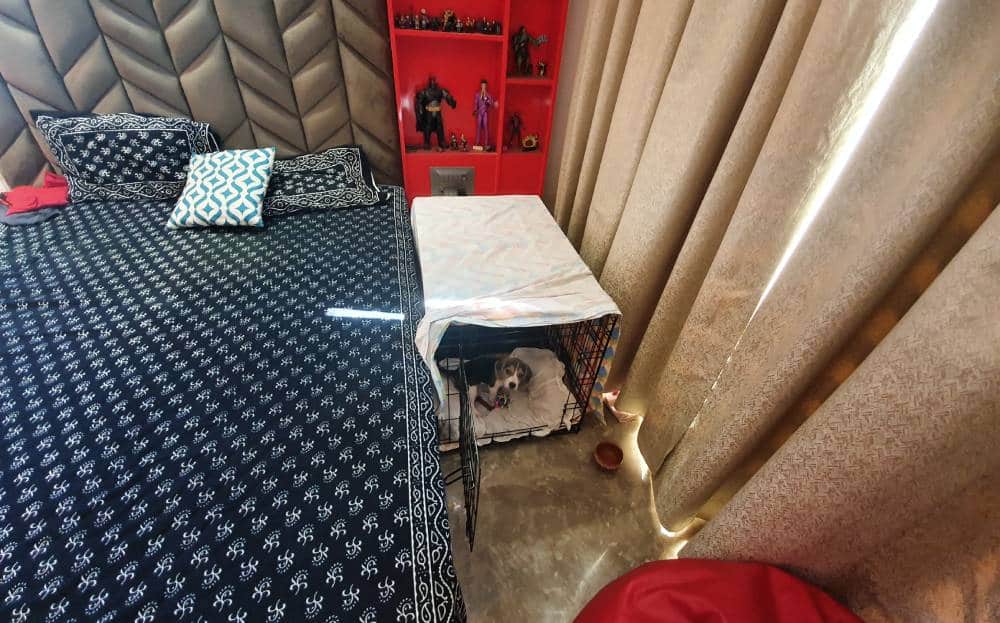
- The crate should be placed in a quiet area where your beagle can have an undisturbed sleep.
- The crate should not be placed in direct sunlight.
- The ideal place that I recommend is your bedroom. Knowing that you are sleeping in the same room will not make your beagle feel lonely at night.
What is an ideal time for Crate training a Beagle?
The ideal time for crate training a beagle is when he is a puppy. In fact, you should start crate training your pooch as soon as you get him. Puppies are comparatively easy to train. As the beagle gets older he becomes more stubborn and would not prefer a change in this lifestyle.
This doesn’t mean they are impossible to train. It would take a little longer to crate train an adult beagle.
Final Thoughts
Do not rush with crate training. It is a long process and crucial to do. It might take weeks until your beagle starts liking the crate. So be patient and do not give up.


